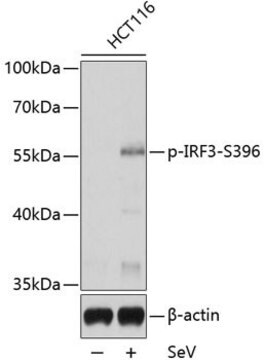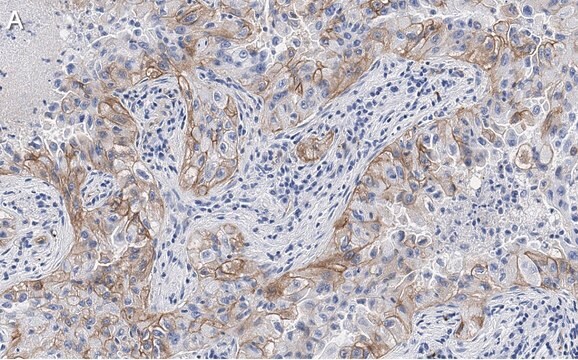詳細
We are committed to bringing you greener alternative products, which adhere to one or more of The 12 Principles of Green Chemistry.This antibody is Preservative-free, produced without the harm or sacrifice of animals and exceptionally stable to allow for ambient shipping and storage if needed and thus aligns with "Waste Prevention", "Designing Safer Chemicals" and "Design for Energy Efficiency".
Click here for more information.
ZooMAb® antibodies represent an entirely new generation of recombinant monoclonal antibodies.Each ZooMAb® antibody is manufactured using our proprietary recombinant expression system, purified to homogeneity, and precisely dispensed to produce robust and highly reproducible lot-to-lot consistency. Only top-performing clones are released for use by researchers. Each antibody is validated for high specificity and affinity across multiple applications, including its most commonly used application. ZooMAb® antibodies are reliably available and ready to ship when you need them.
特異性
Clone 2M20 is a Rabbit recombinant monoclonal antibody that specifically detects Interferon regulatory factor 3 (IRF-3) phosphorylated on serine 396.
免疫原
KLH-conjugated linear peptide corresponding to 15 amino acids surrounding phosphoserine 396 from the C-terminal region of human Interferon regulatory factor 3 (IRF-3).
アプリケーション
Quality Control Testing
Evaluated by Western Blotting in lysate from HeLa cells overnight serum starved and treated with Calyculin A and Okadaic acid.
Western Blotting Analysis (WB): A 1:1,000 dilution of this antibody detected IRF-3 phosphorylated on serine 396 in lysates from HeLa cells overnight serum starved and treated with Calyculin A (50 nM) and Okadaic acid (500 nM).
Tested applications
Affinity Binding Assay:A representative lot of this antibody bound Phosphorylated IRF3-Ser396 Peptides with a KD of 4.7 x 10-7 in an affinity binding assay.
Peptide Inhibition Assay Analysis: Target band detection in lysate from HeLa cells treated with Calyculin A and Okadaic acid was prevented by preblocking of a representative lot with phosphorylated IRF3-Ser396 peptide.
Immunohistochemistry (Paraffin) Analysis: A 1:100 dilution from a representative lot detected IRF-3 in human colon cancer tissue sections.
Note: Actual optimal working dilutions must be determined by end user as specimens, and experimental conditions may vary with the end user
ターゲットの説明
Interferon regulatory factor 3 (UniProt: Q14653; also known as IRF-3) is encoded by the IRF3 gene (Gene ID: 3661) in human. IRF-3 is a transcription factor that is constitutively expressed in a variety of tissues and plays a role in intracellular immune response against DNA and RNA viruses. It regulates the transcription of type I interferon genes (IFN-a and IFN-b) and interferon-stimulated genes by binding to an interferon-stimulated response element in their promoters. IRF-3 contains a DNA-binding region (aa 5-111), nuclear export signal (aa 139-149), IRF-interacting domain, and a C-terminal serine-rich region that contains several phosphorylation sites. It shuttles between cytoplasmic and nuclear compartments, with export being the prevailing effect. In the activated state, IRF3 interaction with CREB Binding Protein prevents its export to the cytoplasm. Although some of these serines are shown to be phosphorylated in the resting state, further phosphorylation of specific residues is required for its activation and nuclear translocation. In uninfected cells, IRF-3 is present in the cytoplasm, however, following infection, it undergoes phosphorylation on serine 385, serine 386, threonine 390, and serine 396. These phosphorylation events induce a conformational change that leads to its dimerization and nuclear localization where it associates with CREB binding protein to form dsRNA activated factor 1 that subsequently leads to the activation of type I interferons and ISG genes. Phosphorylation and subsequent activation of IRF-3 shown to be inhibited by vaccinia virus protein E3. Mutations in IRF3 gene have been linked to infection-induced, Herpes-specific acute encephalopathy that is characterized by hemorrhagic necrosis of parts of the temporal and frontal lobes. This ZooMAb® recombinant monoclonal antibody, generated by our propriety technology, offers significantly enhanced specificity, affinity, reproducibility, and stability over conventional monoclonals. (Ref.: Honda, K., et al. (2006). Immunity. 25(3); 349-360; Kumar, KP., et al. (2000). Mol. Cell Bol. 20(11); 4159-4168).
物理的形状
Purified recombinant rabbit monoclonal antibody IgG, lyophilized in PBS, 5% Trehalose, normal appearance a coarse or translucent resin. The PBS/trehalose components in the ZooMAb formulation can have the appearance of a semi-solid (bead like gel) after lyophilization. This is a normal phenomenon. Please follow the recommended reconstitution procedure in the data sheet to dissolve the semi-solid, bead-like, gel-appearing material. The resulting antibody solution is completely stable and functional as proven by full functional testing. Contains no biocide or preservatives, such as azide, or any animal by-products. Larger pack sizes provided as multiples of 25 μL.
再構成
300 μg/mL after reconstitution at 25 μL per vial. Please refer to guidance on suggested starting dilutions and/or titers per application and sample type.
保管および安定性
Recommend storage of lyophilized product at 2-8°C; Before reconstitution, micro-centrifuge vials briefly to spin down material to bottom of the vial; Reconstitute each vial by adding 25 μL of filtered lab grade water or PBS; Reconstituted antibodies can be stored at 2-8°C, or -20°C for long term storage. Avoid repeated freeze-thaws.
法的情報
ZooMAb is a registered trademark of Merck KGaA, Darmstadt, Germany
免責事項
Unless otherwise stated in our catalog or other company documentation accompanying the product(s), our products are intended for research use only and are not to be used for any other purpose, which includes but is not limited to, unauthorized commercial uses, in vitro diagnostic uses, ex vivo or in vivo therapeutic uses or any type of consumption or application to humans or animals.






![4-シアノ-4-[(ドデシルスルファニルチオカルボニル)スルファニル]ペンタン酸 97% (HPLC)](/deepweb/assets/sigmaaldrich/product/structures/204/925/30ae6ca0-5b0b-4963-a061-7e5e3d1a85af/640/30ae6ca0-5b0b-4963-a061-7e5e3d1a85af.png)


